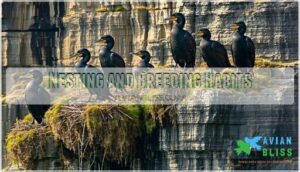This site is supported by our readers. We may earn a commission, at no cost to you, if you purchase through links.
 You’ll find the great cormorant is North America’s largest cormorant, measuring up to 40 inches with a distinctive hooked bill perfectly designed for snagging fish.
You’ll find the great cormorant is North America’s largest cormorant, measuring up to 40 inches with a distinctive hooked bill perfectly designed for snagging fish.
These adaptable seabirds thrive in both coastal waters and inland lakes, showcasing impressive diving skills that let them plunge up to 45 feet deep.
Their sleek black plumage and powerful webbed feet make them efficient underwater hunters, while their social nature leads them to form bustling colonies during breeding season.
Unlike their smaller cousins, great cormorants can hold their breath for nearly a minute while pursuing prey, which is a remarkable comeback from near-extinction that tells a conservation success story worth understanding.
Table Of Contents
- Key Takeaways
- Great Cormorant Description
- Great Cormorant Habitat
- Great Cormorant Behavior
- Great Cormorant Conservation
- Great Cormorant Diet and Breeding
- Frequently Asked Questions (FAQs)
- Where is the great cormorant found?
- What does a great cormorant look like?
- What is a great cormorant?
- Is the great cormorant a competitor for fish?
- Is the great cormorant a threatened species?
- Where do Great Cormorants live?
- Is a cormorant a duck or a goose?
- What is the difference between a cormorant and a Great Cormorant?
- How big are the Great Cormorants in Australia?
- Where are Great Cormorants found?
- Conclusion
Key Takeaways
- You’ll discover great cormorants are North America’s largest cormorant species, measuring up to 40 inches with powerful hooked bills designed for catching fish underwater at depths reaching 45 feet.
- You can spot these adaptable seabirds thriving in both coastal waters and inland lakes across six continents, with their sleek black plumage and distinctive bluish-green sheen making them easy to identify.
- You’ll witness their impressive social behavior during breeding season when they form large bustling colonies on cliffs and trees, constructing bulky nests where both parents share incubation duties for 28-31 days.
- You’re seeing a remarkable conservation success story, as great cormorant populations have recovered from near-extinction to over 1.4 million individuals worldwide through habitat protection and reduced pesticide use.
Great Cormorant Description
You’ll immediately recognize the Great Cormorant as a large, robust waterbird with its distinctive heavy build and thick, hooked bill designed for catching fish.
This impressive seabird displays mostly black plumage with a bluish-green sheen, measuring 33-35 inches in length with a wingspan reaching up to 63 inches, and is notable for its distinctive heavy build.
Physical Characteristics
You’ll recognize these hefty seabirds by their distinctive build and sturdy appearance.
These powerful waterbirds command attention with their impressive size and unmistakable fishing prowess.
Their thick neck supports a blocky head equipped with a heavy, hooked bill perfectly designed for catching fish.
Short legs provide stability while their broad wings enable powerful flight.
Key Physical Features:
- Body Proportions – Heavyset frame measuring 33-35 inches in length with impressive wingspan of 51-63 inches
- Beak Shape – Thick, strongly hooked bill adapted for gripping slippery fish underwater
- Neck Structure – Long, thick neck allows flexible movement while diving and swimming
- Leg Color – Short, dark-colored legs with webbed feet for efficient underwater propulsion
- Feather Structure – Dense plumage with reduced waterproofing that aids diving efficiency
Plumage and Coloration
You’ll notice the great cormorant’s mainly black plumage showcases a striking bluish-green gloss sheen that catches sunlight beautifully.
During breeding season, adults develop distinctive white filoplumes adorning their head and neck, creating an elegant color pattern against their dark feathers.
The bird’s underparts pattern remains consistently dark, while juveniles display browner, mottled plumage texture with remarkably paler bellies, making identification straightforward across age groups with a notable color pattern.
Size and Measurements
You’ll find great cormorants impressive in scale weight and body mass.
These robust seabirds rank among larger waterbirds, with measurements that reflect their aquatic lifestyle.
Key size specifications include:
- Length: 33-35 inches (84-90 cm) from beak to tail
- Wingspan: 51-63 inches (130-160 cm) across outstretched wings
- Weight: 3.3-8.2 pounds (1.5-3.7 kg) varying by season
- Feather Density: Compact plumage supporting diving efficiency.
These measurements place them between crows and geese in overall size, with wing length and body mass adapted for underwater pursuit of fish.
Beak and Leg Features
The great cormorant’s long hooked bill serves as a precision fishing tool, perfectly designed for snagging slippery prey underwater.
You’ll notice their powerful webbed feet act like natural flippers, delivering the powerful strokes needed for agile diver performance.
Their specialized vision adapts quickly between air and water environments.
The unique physical characteristics of these birds, including their leg structure, are similar to those of the marsh bird species.
| Feature | Function |
|---|---|
| Beak Shape | Hooked tip secures fish during dive mechanics |
| Bill Function | Serrated edges prevent prey escape |
| Leg Structure | Webbed toes maximize foot propulsion |
| Foot Position | Set far back for efficient underwater steering |
| Wingdrying Posture | Dark legs support spread-wing drying stance |
Great Cormorant Habitat
You’ll find great cormorants thriving across six continents, from Europe’s coastal cliffs to Australia’s inland waterways, making them one of the world’s most adaptable seabirds.
These versatile birds occupy everything from saltwater coasts and freshwater lakes to urban canals, with northern populations migrating thousands of miles while southern birds stay put year-round, showcasing their ability to thrive in various environments as highly adaptable seabirds, with a wide range of habitats including inland waterways.
Geographic Distribution
Cormorants span the northern hemisphere, establishing colonies across Europe, Asia, and Australasia with expanding regional range.
You’ll spot these adaptable birds throughout coastal habitats from Scandinavia to Japan, with populations reaching Australia’s shores.
Migration patterns shift seasonally as northern flocks move south, while established island colonies serve as breeding strongholds.
Urban expansion hasn’t deterred them—they’re claiming new territories near cities and artificial waterways.
The conservation of bird habitats is essential for maintaining healthy populations and diverse species, which is a key aspect of their ecological balance.
Coastal and Inland Habitats
You’ll discover these remarkable waterbirds thriving across diverse Coastal Ecosystems and Inland Waters, showcasing incredible Habitat Diversity.
Their adaptability spans marine shorelines to freshwater lakes, demonstrating mastery of varied Aquatic Landscapes.
Preferred habitat types include:
- Coastal sites – rocky shores, jetties, and islands for nesting
- Inland waters – lakes, rivers, and reservoirs throughout Europe/Asia
- Urban waterways – artificial lakes and city canals
This Shoreline Ecology expertise makes them true aquatic generalists.
The great cormorant’s ability to thrive in different environments is due to its fishing behavior patterns.
Migration Patterns
Seasonal movements define great cormorant behavior across continents.
Northern populations migrate south during winter months, following established flyway patterns along coastlines. These waterbird migration routes span thousands of miles, with flocks using thermal currents for efficient travel.
Migration patterns vary by region – European birds move between inland breeding sites and coastal wintering grounds, while North American populations make shorter offshore journeys.
Migratory species like cormorants demonstrate remarkable population dynamics, timing departures with weather changes and food availability, showcasing their ability to adapt to seasonal movements and efficient travel patterns, which are influenced by thermal currents and established flyway patterns.
Adaptation to Human Environments
You’ll find great cormorants thriving in urban expansion zones, adapting remarkably to artificial habitats like city reservoirs and constructed wetlands.
Their ecological resilience shines as they navigate coastal development and human disturbance, transforming man-made aquatic ecosystems into productive foraging grounds.
This adaptation demonstrates their flexibility despite increasing human impact on traditional habitats, making habitat protection essential for maintaining these resourceful seabirds.
Great Cormorant Behavior
You’ll observe great cormorants exhibiting remarkably complex social behaviors that showcase their intelligence and adaptability.
These impressive seabirds demonstrate sophisticated foraging techniques, colonial nesting strategies, and diving abilities that make them one of the most successful waterbird species worldwide.
Foraging and Diet
You’ll witness remarkable fish eaters employing sophisticated dive tactics and foraging strategies.
Great cormorants consume 400-600 grams daily, targeting over 250 fish species through pursuit diving.
Their feeding habits include underwater chases lasting 20-40 seconds at depths reaching 10 meters, demonstrating exceptional prey capture techniques.
These seabirds use hooked bills for secure fish consumption while adapting foraging methods to local conditions.
Social Structure and Colonies
You’ll discover great cormorants are masters of colonial nesting, forming massive communities that showcase fascinating social behavior.
These impressive birds establish complex colony dynamics with clear social hierarchy patterns.
Their group defense strategies include coordinated mobbing of predators through alarm calls and synchronized flight formations.
Flock formation occurs naturally as they gather at communal roosts, sharing essential information about food sources and safe nesting locations throughout their range.
Nesting and Breeding Habits
Great cormorants establish breeding colonies on cliffs, trees, and artificial structures during spring.
Males select nest sites first, performing elaborate courtship displays to attract females.
Pairs construct bulky nests using sticks, seaweed, and plant materials, often stealing supplies from neighbors.
Colonial nesting provides protection through group defense against predators like eagles and foxes, utilizing group defense.
Diving and Swimming Abilities
Cormorants excel as aquatic hunters through remarkable adaptations.
Their dive techniques include pursuit-diving from the surface to depths of 30 feet, using powerful webbed feet for propulsion. Unlike ducks, their feathers lack complete waterproofing, reducing buoyancy for easier submersion.
The use of efficient dive fin designs can enhance underwater propulsion for such aquatic birds.
Diving Abilities:
- Swimming Speed – Reach 15 mph underwater using webbed feet propulsion
- Underwater Vision – Clear sight enables precise prey pursuit in murky water
- Plunge Diving – Surface dives shift to pursuit-diving for fish capture
- Aquatic Dexterity – Hooked bills secure slippery fish during underwater pursuit
Great Cormorant Conservation
You’ll find that great cormorant populations face significant challenges from habitat destruction, fishing industry conflicts, and climate change impacts on their breeding and feeding grounds.
Understanding these conservation issues helps protect this adaptable seabird species that has shown remarkable recovery in some regions while declining in others, highlighting the need for continued conservation efforts to address climate change impacts.
Threats and Mortality Factors
Multiple threats plague great cormorant populations worldwide.
Habitat loss from coastal development destroys nesting sites, while climate change alters fish distribution patterns.
Pollution effects include oil spills coating feathers and heavy metals reducing chick survival.
Human persecution through culling programs reflects fishery interests and human-wildlife conflicts.
Disease outbreaks like avian influenza cause mass mortality events in crowded colonies, and these threats collectively impact the species’ survival, highlighting the need to address human-wildlife conflicts.
Breeding Success and Population Trends
Following decades of population struggles, great cormorant breeding success demonstrates remarkable recovery patterns.
Baltic Sea populations grew from 3,133 pairs in 1959 to approximately 210,000 pairs by 2018.
Colony dynamics show consistent nesting success rates of 2.5-2.6 fledglings per nest across regions, with species trends indicating continued population growth despite localized management interventions affecting conservation status.
The age of recruitment is influenced by factors such as conspecific success which affects breeding initiation in great cormorants, reflecting breeding success and population growth.
Human Impact and Habitat Destruction
Human activities pose significant threats to great cormorant populations through multiple environmental pressures.
Coastal development reduces nesting sites while industrial activities introduce toxins into aquatic ecosystems.
These magnificent birds face mounting challenges as their natural world transforms around them.
- Pollution Effects: Chemical runoff and plastic waste contaminate feeding areas, affecting fish populations and bird health
- Coastal Erosion: Rising sea levels and human development destroy traditional cliff nesting sites along shorelines
- Human Encroachment: Urban expansion and recreational activities disturb breeding colonies, forcing birds into less suitable habitats
Conservation Efforts and Protection
Wildlife conservation programs have stepped up to protect great cormorants through thorough habitat preservation and species protection initiatives.
Environmental policies now support sustainable management practices, while bird conservation efforts focus on maintaining critical nesting sites.
International cooperation strengthens conservation status monitoring, ensuring habitat conservation measures effectively safeguard these remarkable diving birds for future generations.
Effective conservation relies on using proper conservation products to support these initiatives.
Great Cormorant Diet and Breeding
You’ll find that great cormorants are opportunistic feeders with a diet consisting primarily of fish under 12 cm in length, though they’ll also consume crustaceans and marine worms when available.
These birds form large breeding colonies where pairs construct bulky nests from sticks and seaweed, typically laying 3-4 pale blue eggs that both parents incubate for approximately 28-31 days before the demanding task of raising their young begins, which is a demanding task.
Food Sources and Preferences
Great cormorants demonstrate remarkable adaptability in their fish prey selection, targeting species under 12 cm across diverse aquatic ecosystems.
Their feeding habits showcase impressive foraging strategies, diving up to 30 feet while pursuing fish, crustaceans, and marine worms.
These seabirds exhibit significant diet variations based on seasonal availability and habitat conditions, employing sophisticated prey capture techniques that maximize their hunting success in both marine and freshwater environments.
Understanding the cormorant’s optimal diet needs is essential for their survival and conservation.
Nesting and Egg-Laying
After securing their daily catch, these remarkable birds turn their attention to nest building during breeding season.
You’ll find cormorant nesting sites concentrated in breeding colonies on cliffs, trees, or artificial structures. Males select the nest site and perform elaborate displays to attract females.
Colony formation provides protection through shared vigilance against predators. Their nesting behavior involves constructing bulky platforms from sticks, seaweed, and debris.
Females typically lay 3-4 pale blue eggs with chalky coatings, completing their egg-laying cycle within the established colony structure. The success of their breeding efforts depends on careful nest site selection to guarantee safety and access to food.
Incubation and Chick-Rearing
Both parents share Egg Incubation duties for 28-31 days, taking turns warming their pale blue eggs.
Chick Growth begins immediately after hatching, with parents providing constant Parental Care through regurgitated fish.
- Incubation shifts – Parents alternate 4-6 hour periods covering eggs
- Chick development – Naked hatchlings gain feathers within two weeks
- Nest protection – Adults aggressively defend nesting sites from predators
Feeding and Fledging Young
Both parents share feeding duties through regurgitation, delivering fish directly into chicks’ mouths during their 50-55 day nestling period.
Young cormorants develop rapidly under this intensive parental care system.
The fledging process begins around day 50, though newly-fledged birds often return to nests for additional feeding sessions lasting 40-50 days, ensuring proper chick development before independence.
Frequently Asked Questions (FAQs)
Where is the great cormorant found?
Imagine if you could spot these cosmopolitan birds everywhere except your local coffee shop.
You’ll find cormorants across Europe, Asia, Africa, Australia, and coastal North America, inhabiting both saltwater coasts and freshwater lakes.
What does a great cormorant look like?
You’ll spot this heavyset seabird by its mainly black plumage with bluish-green gloss, distinctive yellow throat patch, thick hooked bill, and broad wings spanning up to 63 inches.
What is a great cormorant?
A bird in the hand is worth two in the bush" – you’ll recognize a great cormorant as a large, dark waterbird with webbed feet and hooked bill.
They’re expert divers, plunging underwater to catch fish in coastal and inland waters worldwide, which makes them a notable sight.
Is the great cormorant a competitor for fish?
Yes, you’ll find great cormorants compete directly with commercial fisheries.
They consume small fish species that humans harvest, creating economic tensions.
Their efficient diving abilities and social feeding behavior make them formidable competitors in aquatic ecosystems.
Is the great cormorant a threatened species?
Don’t sweat the small stuff—life’s too short to worry about everything.
You’ll find that this species isn’t facing extinction. The great cormorant holds IUCN status as "Least Concern," with populations recovering after near-extinction from hunting.
Current global populations exceed 4 million individuals and continue increasing.
Where do Great Cormorants live?
You’ll find these adaptable seabirds across Europe, Asia, Africa, Australia, and North America’s coasts. They inhabit lakes, rivers, estuaries, wetlands, and increasingly urban artificial waters, thriving wherever fish swim.
Is a cormorant a duck or a goose?
Like separating eagles from hawks, you’ll discover cormorants aren’t ducks or geese but belong to their own distinct family, Phalacrocoracidae.
They’re diving seabirds with hooked bills, unlike waterfowl’s flat beaks for filtering food.
What is the difference between a cormorant and a Great Cormorant?
Cormorants represent a family of waterbirds, while you’ll find Great Cormorants are the largest species within that family.
They’re distinguished by their impressive size, thick hooked bills, and distinctive breeding plumage features.
How big are the Great Cormorants in Australia?
You’ll spot Australian Great Cormorants measuring 70-102 cm in length with wingspans reaching 121-160 cm.
They’re hefty birds, weighing between 5-3 kg, making them substantial waterbirds you can’t miss along coastlines.
Where are Great Cormorants found?
Across six continents, you’ll discover these versatile birds inhabiting coastlines, lakes, rivers, and wetlands from Europe through Asia, Africa, Australia, and North America’s eastern shores.
Conclusion
Haven’t you ever wondered how a species can bounce back from the brink of disappearance?
The great cormorant’s remarkable recovery demonstrates nature’s resilience when proper conservation measures are implemented.
Through habitat protection, reduced pesticide use, and careful population monitoring, these skilled diving birds have successfully reestablished stable breeding colonies across North America.
You’ll find that understanding the great cormorant’s ecology helps appreciate both wildlife conservation successes and ongoing environmental challenges facing seabirds today, highlighting the importance of conservation measures.
- https://www.birdlife.org/news/2022/06/02/seabird-of-the-month-great-cormorant-phalacrocorax-carbo/
- https://www.ynetnews.com/environment/article/bytesdjykl
- https://planetofbirds.com/great-cormorant-phalacrocorax-carbo/
- https://helcom.fi/wp-content/uploads/2020/06/BSEFS-Population-development-of-the-Great-Cormorant.pdf
- https://australian.museum/learn/animals/birds/great-cormorant/











